Woodworking as an escape from the absurdity of software
How software dev requirements drove me crazy enough to start learning a new trade
April 28, 2024
Some of you might remember the legendary comment of Eric Diven on a Docker CLI issue he opened years ago:
@solvaholic: Sorry I missed your comment of many months ago. I no longer build software; I now make furniture out of wood. The hours are long, the pay sucks, and there’s always the opportunity to remove my finger with a table saw, but nobody asks me if I can add an RSS feed to a DBMS, so there’s that :-)
I say legendary because it has over 9000 reactions and most are positive. There’s a reason why so many devs resonate with that comment.
A lot of us said at some point things like “I’m gonna throw my laptop out the window and start a farm”. Even my last team leader sent me a message out of the blue saying “I think I’ll run a bar. I want to be a bartender and listen to other people’s stories, not figure out why protobuf doesn’t deserialize data that worked JUST FINE for the past three years”.
You know the drill, sometimes the world of software development feels so absurd that you just want to buy a hundred alpaca and sell some wool socks and forget about solving conflicts in package.json for the rest of your life.
I went through those stages too: when the Agile meetings at my last job got so absurd that we were being asked to estimate JIRA task time in T-shirt sizes, I took the decision to quit that comfy well paying job for the uncertainty of making a living from macOS apps. I had only one app that didn’t even work on the latest Apple Silicon chips, and it was making $0, so I really took a bet with it.
Recently, when people started coming with so many unrealistic and absurd expectations and demands about what my apps should do, I started thinking if it would be possible to leave software development for a more physical trade.
# A bit of history
Most of my pre-college time was spent on things I didn’t want to do.
I had a bit of childhood, but then I started going to school 6 hours per day, with 1-2 hours spent on commute after 5th grade. I only liked the 10-minute breaks between classes where I played basketball or practiced parkour.
Every day after I came back from school, I had to work in agriculture, either out in the field with crazy winds and sun and UV radiation, or inside a 100-meter long greenhouse where it’s either a 50°C sauna or a muddy rainforest. I was very bad at every job I was given, but it’s what my parents did for a living and I had to help them, no questions asked.
The few hours that remained, usually very late at night, tired both physically and mentally, I spent practicing acoustic guitar, doing bodybuilding exercises, writing bad poetry or drawing graphite portraits.

I almost never did homework or memorize whatever had to be memorized for the next day of school. I just couldn’t justify spending those few hours I had left on even more stuff I did not want to do.
When I found my liberty in college, hundreds of kilometers away from my parents, it’s like something clicked. I suddenly became incapable of doing work that I found meaningless.
Failing classes became acceptable, quitting jobs was something I did with little remorse if I felt I wasn’t helping anyone with the work I was assigned, and bureaucracy became a disease I had to avoid at all costs.
I still washed the dishes though. Cleaning and other “chores” never felt meaningless for some reason.
# The first wood thing I did
… was a chess board and piece set. With magnets inside them. Where the pieces look nothing like ordinary chess pieces.
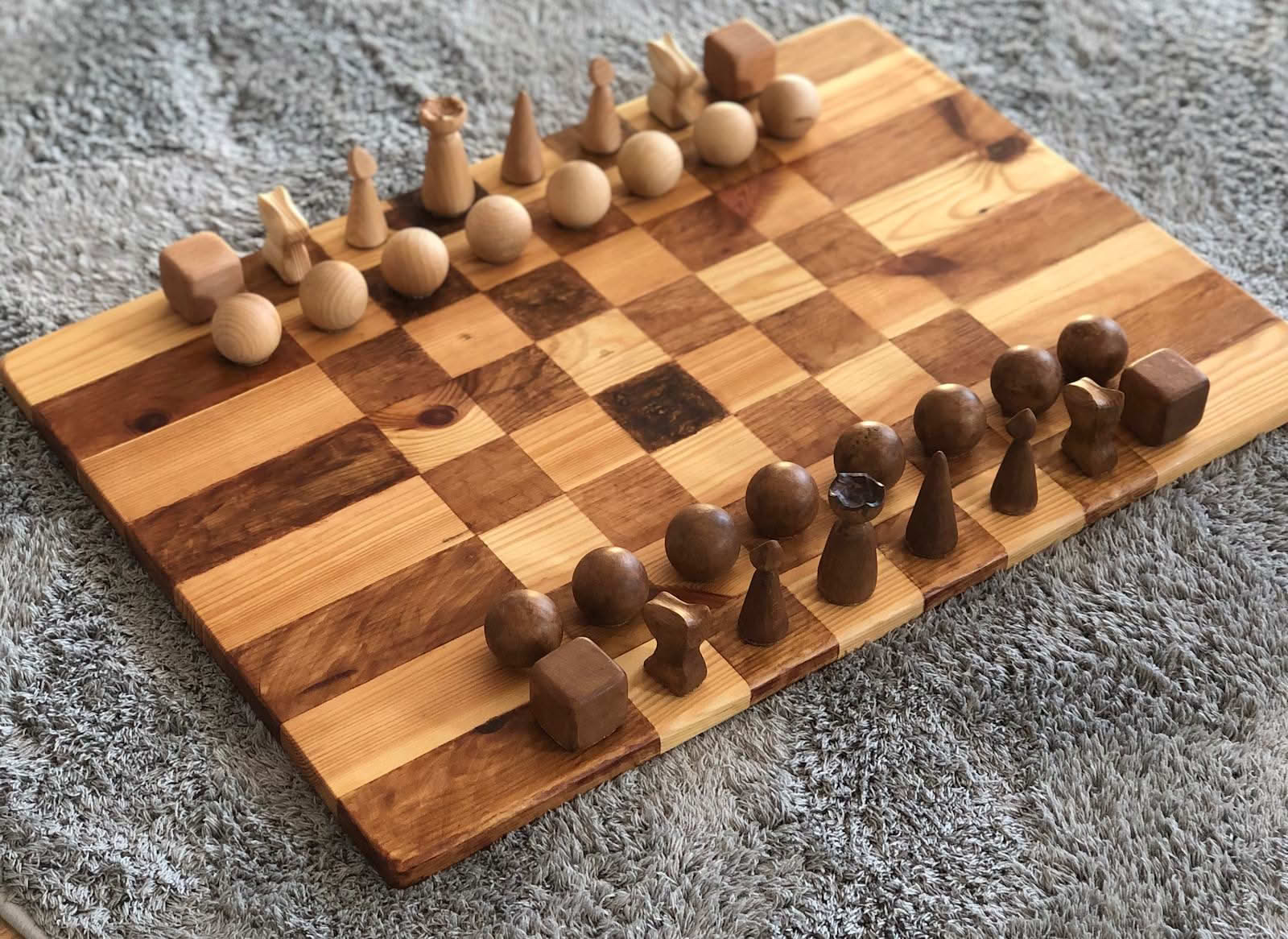
I was trying to get the pieces to snap into place in a satisfying way, and make sure the game stays that way when kids or dogs inevitably bump the table where the board sits.
You know how Magnus Carlsen always adjusts his pieces so meticulously before a game? Well I have half of that obsession as well so I wanted to avoid doing that.
# How it was done
I started with a cheap but hefty pine board which I rounded with a lot of sandpaper. Then I asked my wife to help me colour in the darker squares because I’m pretty bad at colouring inside the edges (both literally and figuratively). We used some wood floor markers for that and the colour seems to be holding well.
Most chess board builds you see on YouTube are done by gluing squares of different wood species with alternating colors, but I had neither the skill nor the tools to do that.
Then I drilled holes for the super strong neodymium magnets from the underside of the board, having to get really close to the top side without passing through. I failed on two squares, but some wood putty took care of that.
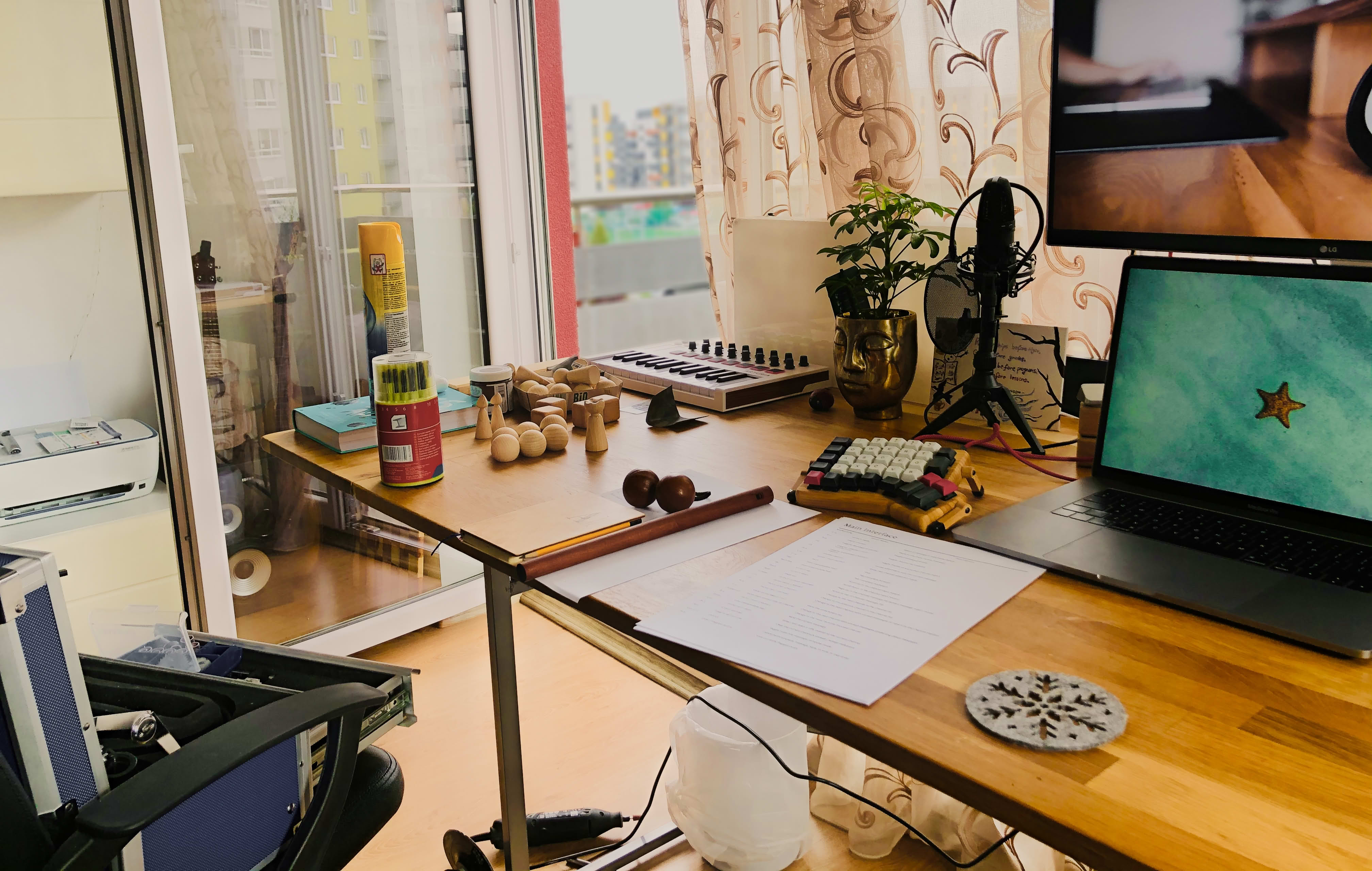
I spent a few sunny days on the balcony sculpting the pieces with a badly sharpened knife and my Dremel. This was quite satisfying, there’s something really nice about seeing a non-descript rectangle take the shape of a little horse in your hands. I mean knight, but in Romanian that piece is called “horse”, and I really don’t see any knight there.
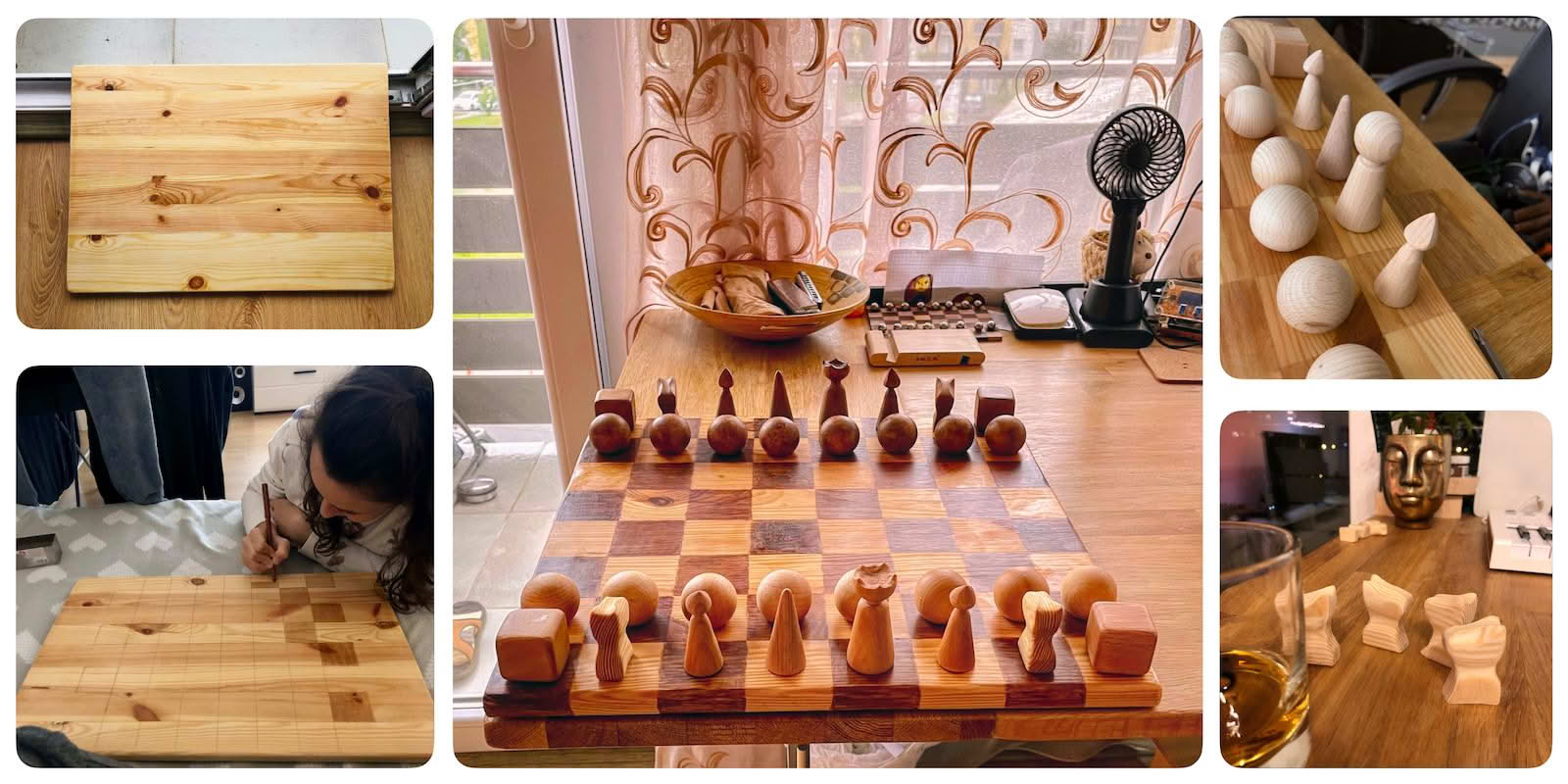
Regarding the design, I got some inspiration after seeing these modernist chess sets, which not only looked beautiful in my eyes, but also had these geometric shapes that didn’t need that much sculpting to replicate. I found ready-to-buy spheres and cubes of wood at a craft shop around me (which took care of pawns and rooks), and the rest were carved out of rectangles and cones of wood.

# Kaval
Two Octobers ago, a Romanian music band called Subcarpați was holding a free “make a Kaval with your own hands” course, where a flute artisan taught the basics of his trade for a week.
The Kaval or “caval” is a long flute with 5 holes and a distinct lower register where notes can sound melancholic and coming from far away, as opposed to the thin cheerful sound of the small shepherd flute.
Ever since I bought my first Kaval, I always wanted to learn how to build one myself. It’s one of those trades where there’s very little info on the internet, so it feels almost mystical compared to what I’m used to in programming. I would also have the chance to walk home with the finished flute, so of course I went to the course.

I loved the fact that we worked in teams of two, and that everything had to be done by hand with no power tools. Even the long bore through the 70cm branch of elder tree had to be done with a hand drill, taking turns to rest our hands.
The artisan had been a shepherd himself since childhood, and taught himself with a lot of trial and error about how to build good sounding flutes and how to make the holes so that the flute stays in tune. But he didn’t know why the holes should be at those specific distances or why the wood tube should be of that specific length for each scale.
I wanted to know those things, because I had an idea of making a universal Kaval that can play in any scale.
You see, if you want to play on top of songs in various scales, you need a Kaval made for each specific scale. So you’ll need an A minor flute, and a B minor one and a C minor one and so on, for a total of 12 different flute lengths.
I eventually found info on how a flute works by thinking about it as an open or closed tube where the vibrating air creates nodes and antinodes that should coincide with the hole position. At the moment I’m still studying this and working towards my “universal flute” goal.
# What does this have to do with software?
For the past 10 years I lived in rented apartments, usually at the 3rd or 4th story with no access to a courtyard. I was never able to get used to that, given that all my childhood I lived and played in a 2000m² courtyard, on a road where there were more slow horse carriages than noisy cars.
This year I moved into a rented house with a tiny but welcoming garden and a bit of paved court and only now I notice the effect this has had on my mind and behaviour.
I develop macOS apps for a living, and there are some unhealthy things in this field that piled up over the years. I get a lot of messages in a demanding and negative tone, and because walking outside the apartment meant unbearable car noise, obnoxious smells and zero privacy, I always defaulted to simply acting on the feedback, putting up with it and working long hours into the night, instead of going for a walk to calm down.
A few months ago, the most absurd demands started coming up for my apps: things like “why does your app not control the volume of my <weird sound device>? why don’t you just do it, people pay you for it” when the app in question is Lunar, an app for controlling monitor brightness, not sound devices.
Or “why do you disable your apps from working on Windows?”, or “make Clop compress text and copy it to clipboard” (where Clop is my app that automatically compresses copied images, videos and PDFs, I have no idea what compressing text even means in that context).
But this time, I was able to simply walk out the front door, grab a branch of beech wood, and, because I remembered my wife saying we forgot to package the french rolling pin when moving, I took out my pocket knife and started carving a simple rolling pin for her. It was so liberating to be able to just ignore those messages for a while and do something with my hands.

I understand that those people don’t know better, and they would have no idea that there’s no checkbox where you can choose whether an app works on macOS, Windows or Linux. I understand how if the app does something with audio volume or compression, some think that it should do everything related to those workloads, even if it’s completely outside the scope of the app.
But the combination of the negative tone and getting message after message, some people being so persistent that they insist on sending me those messages through all possible mediums (email, Discord, Twitter, contact form, they’ll find me everywhere), makes it hard to just ignore them.
There’s also this oily smell of AI and machine learning in the tech atmosphere, where I no longer feel relevant and I seem to have stopped caring about new tech when I noticed that 8 in 10 articles are about some new LLM or image generation model. I guess I like the smell of wood better.
# Side tangent on privileges of being a software dev
I know I’m privileged to even be able to have the choice of what to do with my time. I got lucky when I chose a computer science university at the right time which allowed me to progress towards a huge semi-passive income in the last 10 years. that doesn’t mean I didn’t work my ass off, but luck plays a huge role too
I got “lucky” to have my mind traumatised into some kind of OCD-like state where I hate leaving a thing unfinished. So I plow through exhaustion, skip meals, miss house chores and annoy dear people around me because I know “I just need to fix this little thing” and I’ll finish this app/feature/task I started. Even though I also know there’s no real deadline and I can leave it half-finished for now.
But even if it sounds annoying for a person like me to whine about how I don’t feel good or I feel burnt out, the privilege doesn’t negate the feelings. The regression to the norm will make everyone, rich or poor, get used to the status quo and complain about every thing that’s just a little worse than their current state. That’s happiness and sadness in a nutshell.
I’m also vaguely aware that software dev as we know it is about to disappear soon, and I got tired of learning the newest thing just to have it replaced next year. I got tired of back pain and chronic finger pain from so many hours of sitting and typing, I’d rather have pain from work that also builds some muscle.
And I got so tired of everything being online, immaterial, ephemeral and lonely, like indie development tends to be.
# Woodworking with cheap tools and free wood
This house we rented is small and the owners had to fit the bedroom upstairs. I really don’t like climbing stairs up and down, especially when I have to let my dog out three times per night. So we gave up a room and started furnishing our own bedroom downstairs.
I didn’t want to buy bedside tables for the price of the bed itself, so I thought I could maybe make by own. I’m not yet skilled enough to build my own bed though, so we bought that
One day, while walking with my dog, I noticed that some trees were getting trimmed in the vicinity of our house and there were a lot of white birch branches on the side of the road. I said why not?, grabbed some branches and walked like a lunatic with white long sticks dangling up and down and a black dog zig-zagging left and right, all the way home.
I had another small pine panel left from that chess project so I started thinking about the simplest way to turn what I have into a bedside table.

I used low-grit sandpaper to give the board some nice round corners because I love squircles, swallowed about a spoonful of sawdust because I couldn’t find any breathing mask left, criss-crossed 4 branches in a way that would give a stable base, and screwed them to the underside of the board with long wood screws.
The legs would wobble around though, so I drilled small 3mm holes into each branch where they met in the middle, and weaved a florist wire through them to keep the table steady.

# The laptop bed table
After I’ve shown the bedside table to a friend of mine, he said he also needed a laptop table for those mornings when he’d rather not get out of bed. I wanted to say that’s not very healthy, but what got out instead was sure thing, I’ll do it!. Oh well..
I still had the large desk top I glued from smaller beech boards, on which I worked for the past 4 years. It stayed unused currently, so I cut part of it and built this cute thing:

You’ll notice three defining features that every laptop table should have:
- a hole for a charging cable
- a carved coaster for the coffee cup
- a mildly surprised face? 😦
To tell the truth, all those are side effects of me drilling holes where there should be no hole, and dropping the board on the ground multiple times because my workbench was not large enough. All the things that could go wrong, went wrong with this table.
I hid the defects by turning them into features.
The whole truth actually is that the table looks nothing like what I planned. I bought these nice hidden brass cylindrical hinges to make the table foldable. That way, you could fold the sides flat inside and use it as some kind of armchair desk if you wanted.

I wasn’t able to drill the correctly sized or positioned holes for the hinges because I still lack a lot of knowledge and skill in working with wood. So after losing my temper with the frickin’ hinges that still didn’t fit after a full day of drilling and chiseling, I glued the sides and inserted 2 trusty long wood screws per side, which I patched with a glue gun that made the screw holes look like eyes.
After I also carved the handles, the table grew kind of a personality of its own, as you can see above.
Why didn’t I do some wood joints, like a dovetail instead of ugly screws and glue?
Because I had no idea they existed. Also, I wasn’t able to fit a simple hinge, I would have probably never finished this table if I tried learning wood joinery on it.
This reminds me of how whenever I did pair programming with a colleague, I noticed how they were doing some “nonoptimal” action and I would say:
Why don’t you just use
ripgrepinstead of sifting through all these files?
Because they don’t know it exists, stupid. Or because they just want to get this thing done and move on, they don’t grep files all day like you do.
But in my ignorance, I seem to have chosen a good enough joining method. As you can see in this wood joinery comparison, 5cm (2inch) screws can hold more than 50kg (110lbs) of force, and I used even longer screws so I think it’s going to hold a 3kg laptop just fine.
Oh right, forgot about this little detail.. I also added a cork pocket for holding a notebook, tablet, phone etc. which I lined with a microfiber cloth on the inside for strength and sewn to the wood with that leftover alpaca wool for style.

# The bookshelf without books

While we were stuck in the apartment in the 2020 pandemic, me and my wife bought a lot of stuff that we thought would help us learn new things and start new hobbies. I thought I’m going to build smart LED lighting all my life and my wife would become a professional wool knitter. We were losing our minds, for sure.
So now we were stuck with crates of stuff we haven’t used in years, and didn’t want to start unpacking them around the house. The clutter that followed after the pandemic, tired our minds just as much as the lockdown itself.
We dumped the crates on an unused stairway spot, and I thought that a bookshelf as large as that spot would clear the clutter.
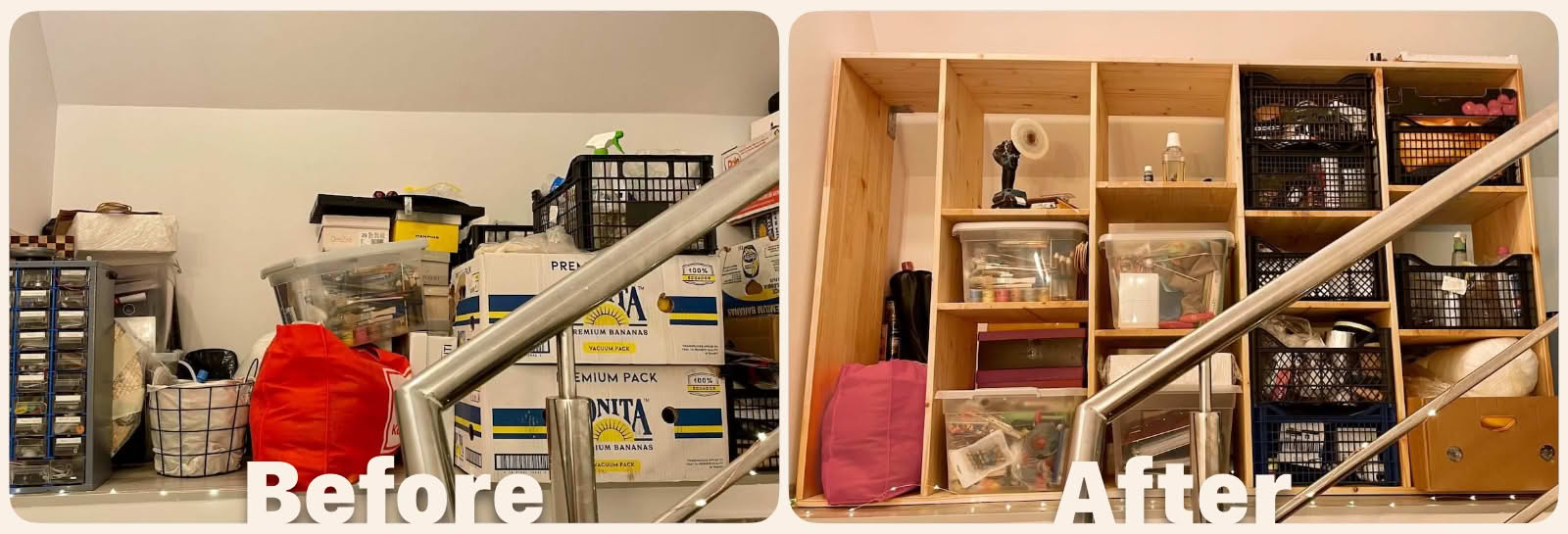
But I could not find any bookshelf that large, certainly not for cheap. So I traced a few lines in Freeform, took some measurements, and ordered a bunch of large pine boards and a ton of long screws.
I also ordered the cheapest portable workbench I could find ($30) that had a vise, so I can stop making sawdust inside.
A few days later, I got to sawing the shelves with my cheap Japanese pull saw I bought from Lidl years ago.
Hint: Hand sawing a long wood board with no skill will certainly end up with a crooked edge. Stacking up 5 boards one on top of the other will still end up crooked.
Uhm, I guess the hint is, buy a track saw, or make sure the crooked edge isn’t visible.
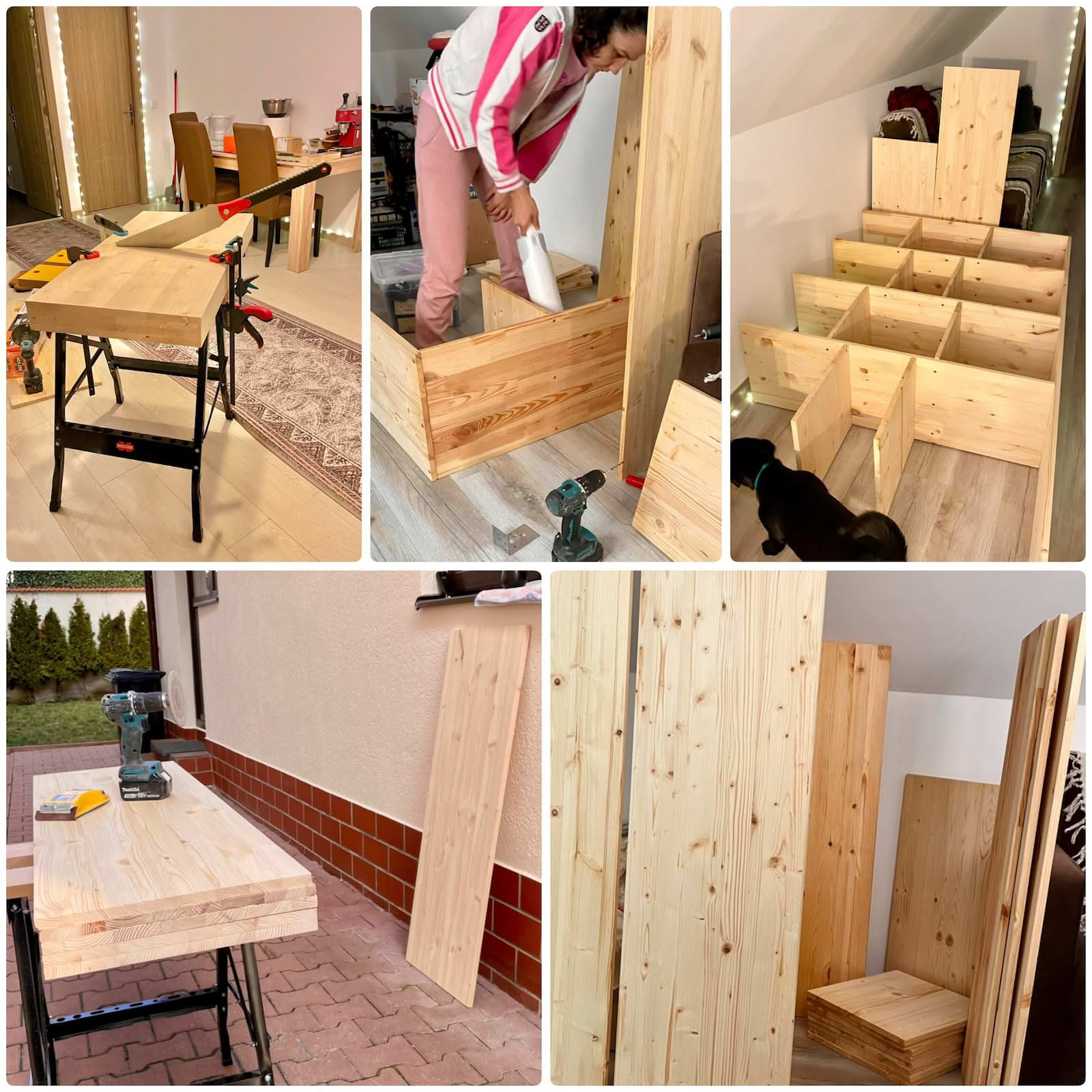
My wife helped a lot with measuring and figuring out where to drill holes and place the screws, while my dog inspected the work regularly to make sure the defects were hidden correctly.
It took two days of screwing.. erm.. driving screws, I mean. But in the end we got the result we wanted! And I got sores in my right arm for days, driving those long screws is harder than I thought.
# The desk that became a workbench
In the thumbnail of this post you can see the current “workbench” I use, which is basically that $30 vise workbench I bought for the bookshelf, with the top of my previous “coding desk” attached in the front.
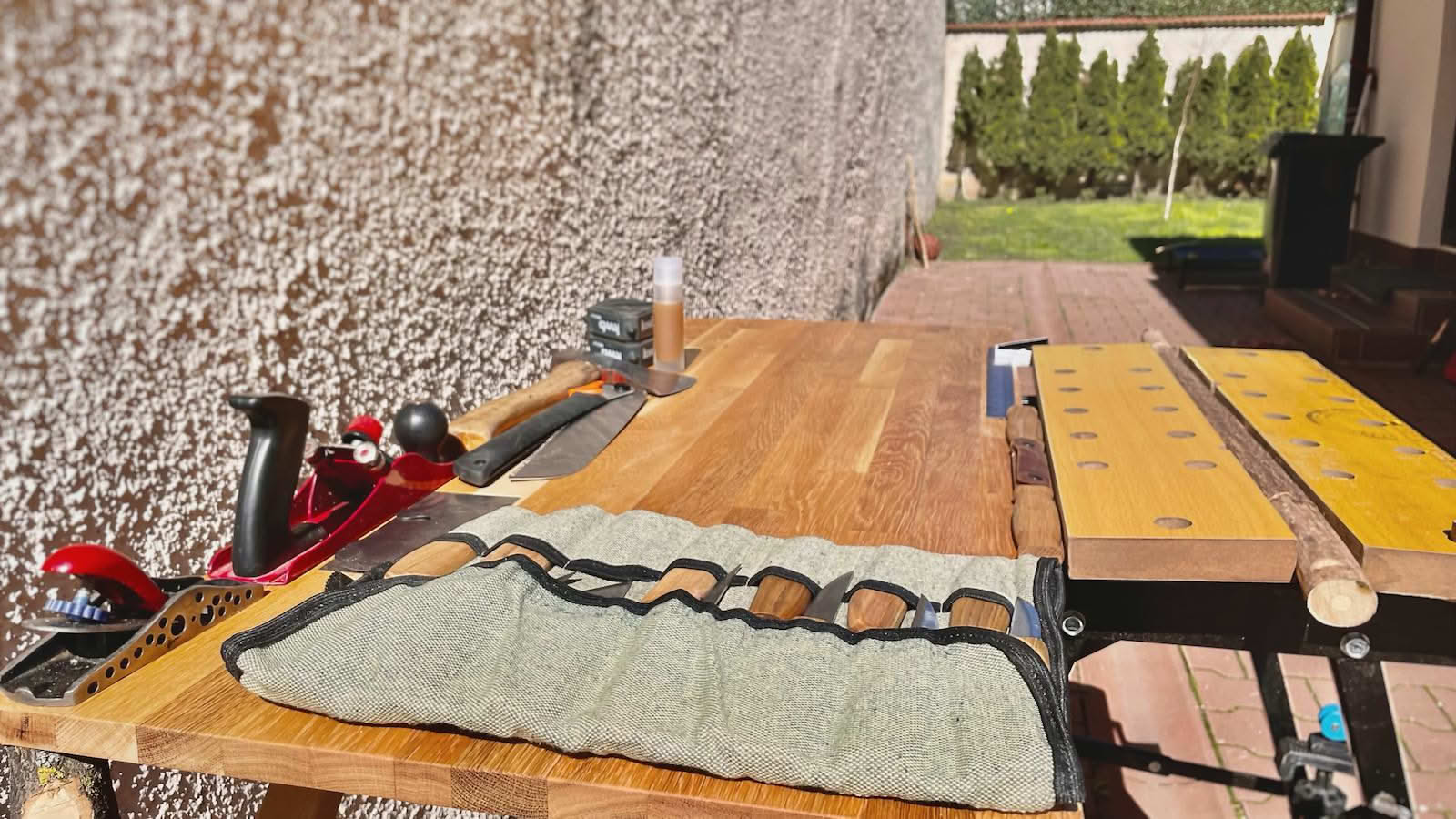
In the image you can see (bottom-left to top, then right):
- the cheapest block plane I could find ($8)
- a red no-name plane I found in the shed of that 100-year old house that we never finished rebuilding
- an axe I found rusted and partly broken in the same shed, on which I learnt how to sharpen and restore axes
- a folding japanese pull saw that I take everywhere with me
- some grip blocks on which I place boards for sanding
- a bottle of Osmo Polyx oil I use for finishing
- a set of carving knives from Beavercraft (really good and they were available at a nice discount)
- a combination square (tucked somewhere at the top of the bench)
- a branch of elder tree, which is prepared for drilling a hole through it for making a kaval
I also own some no-name chisels that work well enough and some card scrapers that I still struggle sharpening.
The only power tools I have are a Makita drill and a random orbit sander on which I did spend some money, an old circular saw I found in that old shed (it was good enough to cut miters on that laptop table) and a Dremel I use rarely because I don’t like its power cord. I prefer battery powered tools.
# The window bench
Our dog Cora loves sitting at the window, growling at old people and barking at children passing around. Yeah, she’s terrified of children for some reason.
But the window sill is not wide enough and her leg kept falling with a “clang” on the radiator below. So I widened it by placing two glued up boards of pine on top of the radiator, that I planed and smoothed beforehand.
This is when I learned that a hand plane is not some antique tool that nobody uses anymore, but a quite versatile piece that can easily smoothen grain where I would waste 5 sheets of sandpaper and choke on sawdust.
I had to still let the heat radiate somehow, so I drilled large holes with a forstner bit, but I also blew the grain fibers on the underside because I had no idea of this possible problem. Turns out there is a simple solution to drilling large holes without ripping the fibers:
- Drill a small 3-6mm hole in the center with a normal wood drill, all the way to the other side (this will help see where the forstner bit should be place from both sides)
- Place the forstner bit in the hole (this also helps with keeping the bit centered) and drill the large hole, stopping midway through the board
- Turn the board around and repeat step 2 until you meet the other end of the hole
We also wanted to sit with Cora and there was not much space between the bed and the radiator, so I built a narrow bench. I used another two pine boards of the same size, but this time glued them on the side to create a wider board.
For the legs, well the tree trimming continued near us, so one day I found some thick cherry branches which I brought home, scraped the bark from them, then attached them to the bench using screws from the top side.
I was ok with a rustic look so I didn’t spend much on finishing, patching holes, or even proper wood drying. I did use the hand plane to chamfer the edges though, I love taking those thin continuous wood shavings from the edge.
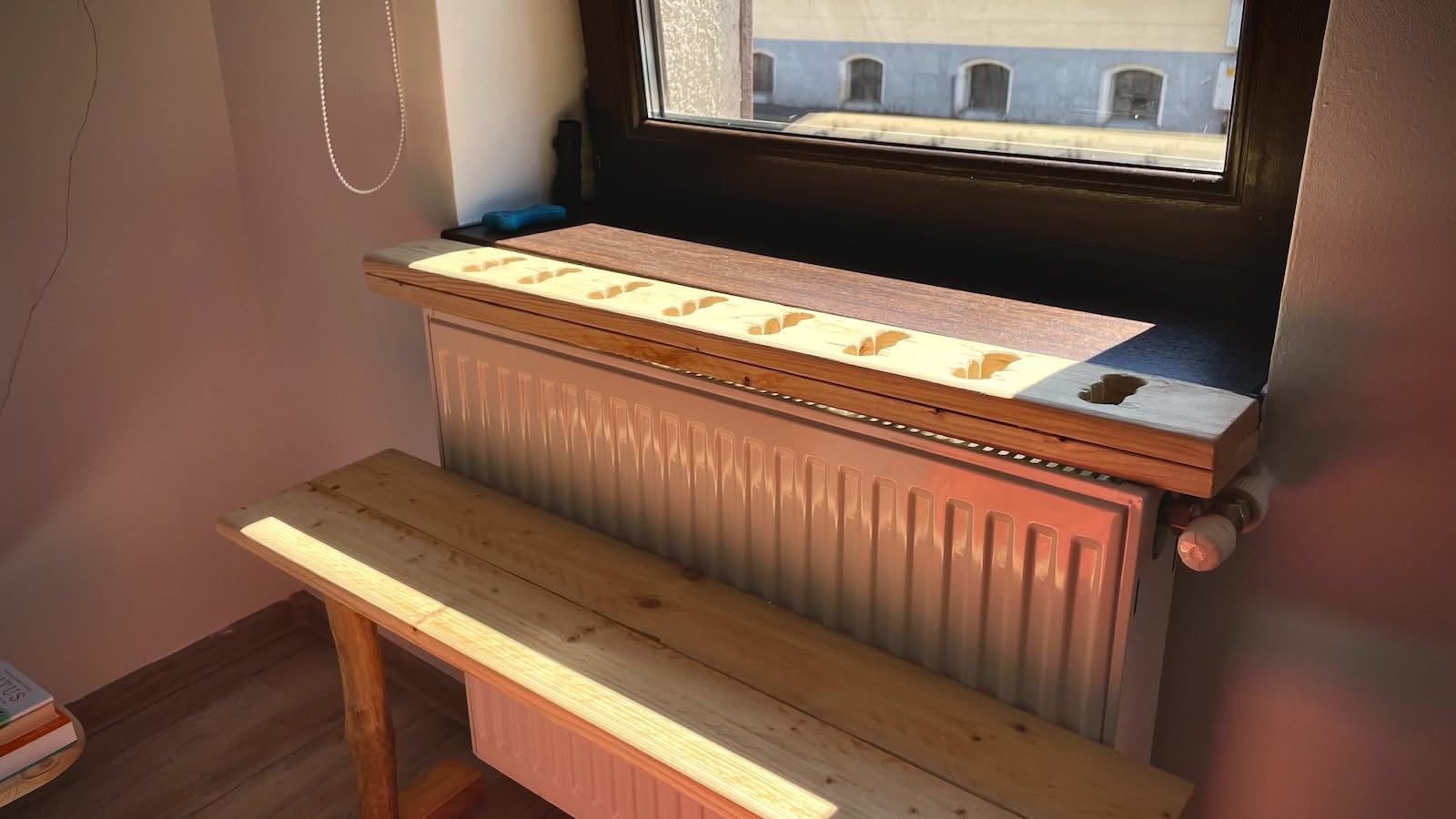
# The trunk coffee table

We recently visited my parents, and loved how the grass finally started growing in some spots where their house and court renovation was finished and was no longer spewing cement dust. It was an abnormally sunny April and I wanted to chat with them at a coffee outside in the early morning before they started the field work, but there was nowhere to place the coffee outside.
First world problems right? If you read about The tail end, you might already understand why a trivial thing like coffee time with my parents feels so important to me.
So one day, while walking on a gravel road near their house, I noticed one neighbour had these huge logs of beech that were recently cut. I thought that would be easy to turn into a small exterior coffee table, so I went to ask if I could buy one.
Well I kind of had to yell “HELLO!” at their gate because I didn’t know their name, and did that a few times until a seemingly sleepy old man appeared at the front door (it was 5 PM) asking what I want. I asked how much he’d want for one of those logs, but he just said to get one, no money needed. Ok, there’s no point in insisting, I chose a wide enough but not too wide log, because these things are heavy and I wasn’t sure I could lift it, and rolled it slowly back home.
I didn’t have my usual tools at my parents house, so I improvised. I found a battered cleaver which my dad used for chopping kindling for the barbecue. I sharpened it as well as I could, then used a hammer to roll a burr on the back of the cleaver that I could use for scraping.
Beech wood has such a smooth hard wood under the bark that it didn’t even need sanding. I used my dad’s power planer to smooth out the top and make a quasi-flat surface then finished it with some walnut oil and it was (almost) ready!
Because the wood was so green, it was certain that it will crack and roughen as it dried. So I cut a groove and wrapped a flat iron band around the top to keep it from moving too much. The bottom can expand as much as it wants, I’m actually quite curious to watch the table morph throughout the summer as we use it.
# The orchard bench
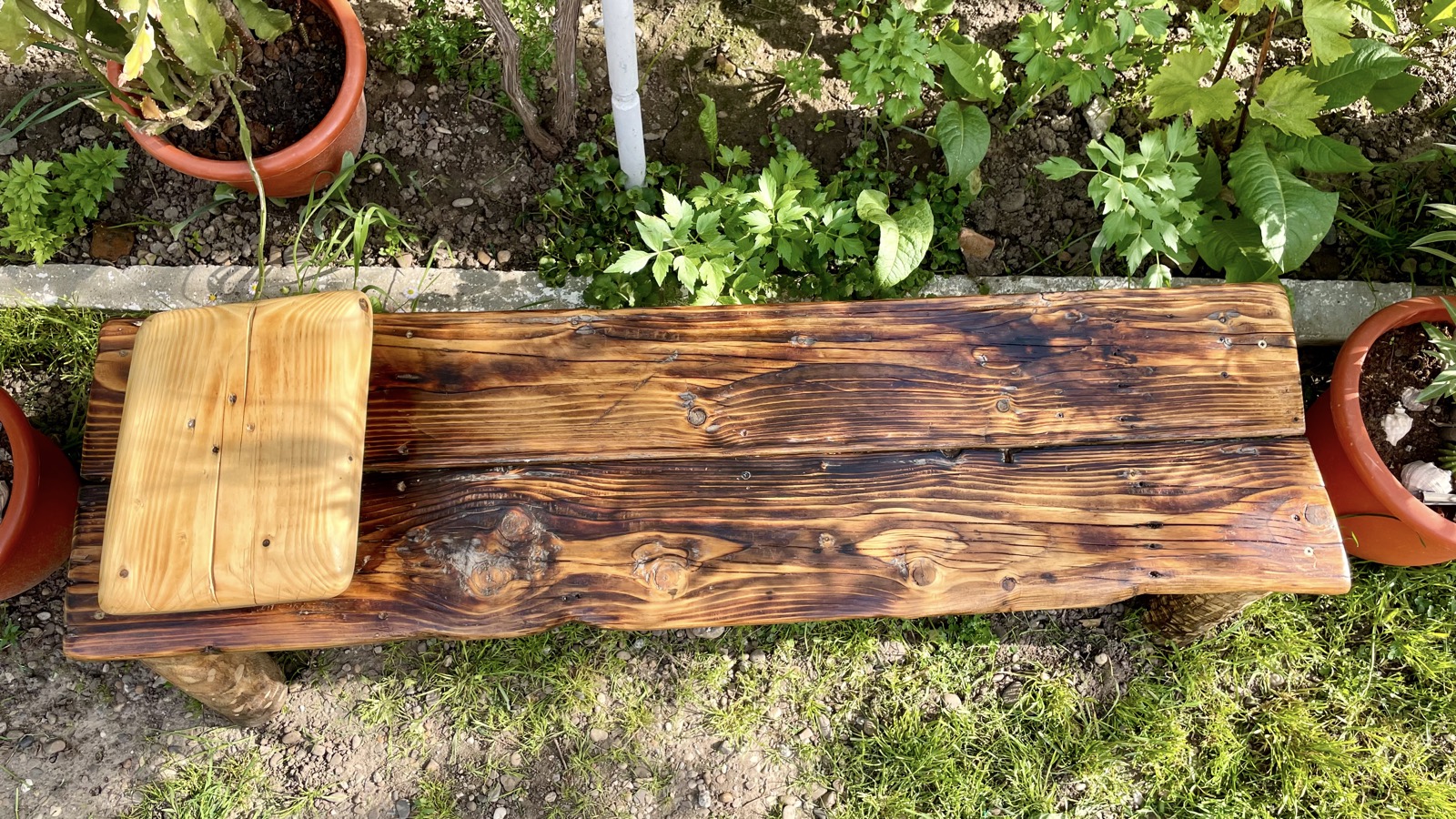
Because we were born in villages that aren’t that far apart, me and my wife always visit both our parents in the same trip. This time when I got to my parents-in-law, I took a stroll through their little orchard. They added new trees this year! I can’t wait to taste the large apricots.
What struck me as odd about the orchard was that there was no patch of grass to lay on. They like digging up the soil every year, and leaving it like that: an arid looking patch of land made of dry dirt boulders. I thought a bench would be a good solution and what do you know, there was an old broken door thrown in the firewood pile just outside the orchard, that had the perfect length and width for a bench.
I forgot to take a photo of the door, but it looked kind of like this one, only worse and with a large rhomboid ◊ hole at the top.

I got to work immediately, dismantling the door piece by piece and pulling out nail after nail (they really liked their nails in those old times). I was left with two long and narrow wooden boards, a pile of rotten wood and two pocketfuls of rusted nails.
I sawed the broken ends of the boards, then I used my father-in-law’s power planer to remove the old gray wood from the top, bottom and sides to get to the fresh wood below. There were a lot of holes and valleys so I had to scrape them by hand with sandpaper rolled around a screwdriver. This took a few more days than I expected, but I eventually got two cleanish boards of.. fir? pine? No idea.
I used a velcro sandpaper attachment for the battery powered drill to sand out the rotten sides and give the boards a curvy and smooth live edge.

For the legs, I stole some more firewood from their pile, where I found some thick branches of unidentified species that were roughly the same length. Stripping the bark with an axe made them look good enough so I screwed them at the four corners of the board. The bench was wobbly with just the legs, so I strengthened it sideways by adding shorter and thinner branches of more unidentified wood between the legs and the center of the board.
I had to do something with the rhomboid ◊ hole, so I filled it with a square 4-by-4 salvaged from a recently dismantled shed, and now the bench has 5 legs. Instead of sawing the leg to size, I left it protruding above the bench and placed another thick salvaged board on top of it to serve as an arm rest, or coffee table, or a place for the bowl of cherries.
For the finish, I burned the bench and the bottom of the legs to get a honey-brown aspect and to make it water resistant. I put a very thin layer of whatever wood lacquer I found in my in-laws shed, just for resistance because I don’t like glossy wood.

# Other small wood things
# Water glass shelf
We don’t have much space on the current eating table, so I built a two-shelf stand where we can place the always present water filter jug and the glasses and free up some of the center space.
It’s incredible how strong just a few screws can be.

# Kaval stand
I thought I should finally do something about the kavals always rolling around on some table or couch throughout the house, so I made a stand from long thin wood boards glued on the side, and finished it with sunflower oil to give it a golden/orange colour.
This way I can always expand it by adding more boards to the side if I want to add more flutes.
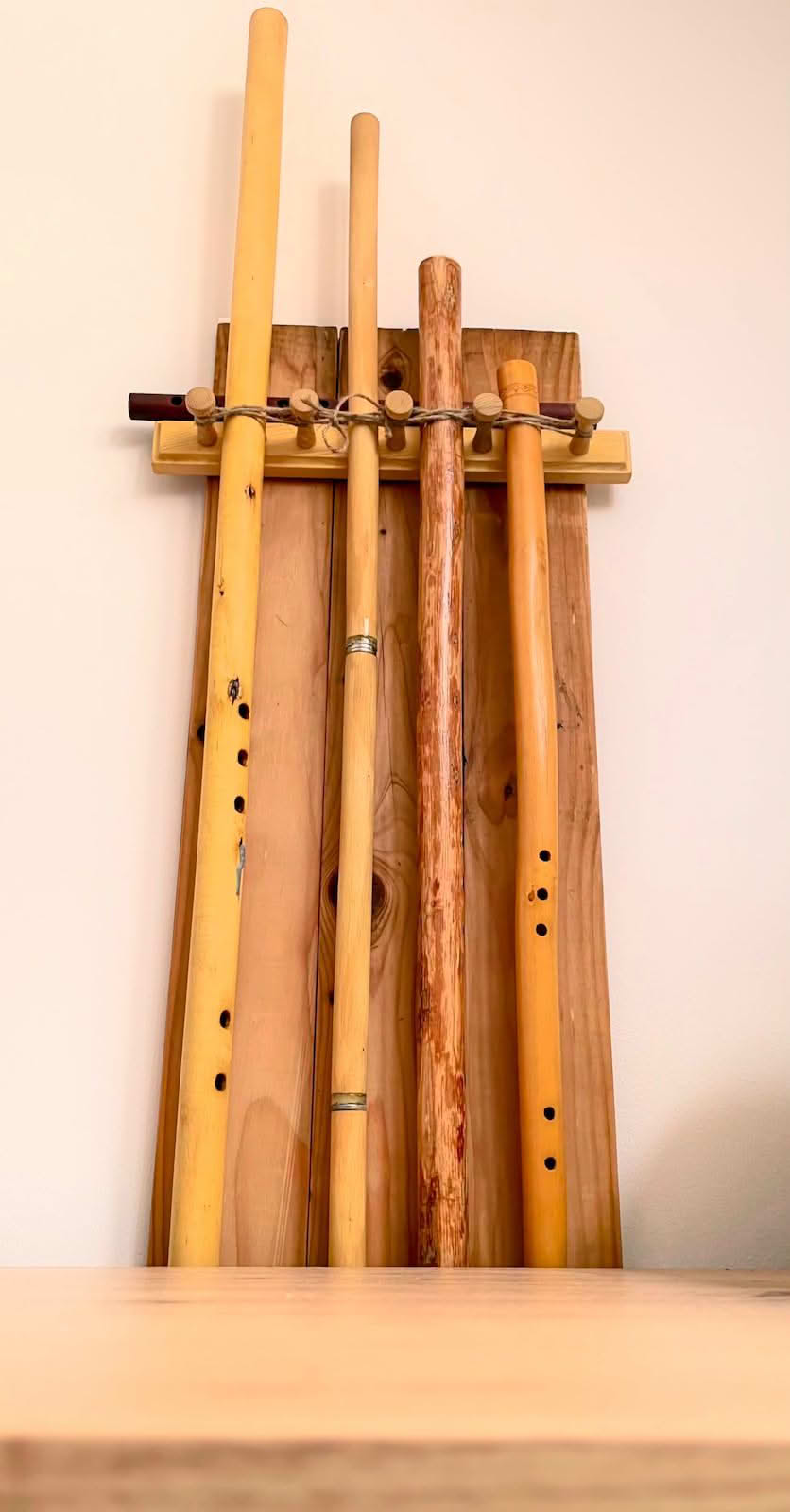
# Sharpening block
I need to sharpen blades almost daily, be it the pocket knife, axe, plane blade or chisels. So I made a custom sharpening block with the perfect tools for my sharpening technique.
It has a $5 diamond plate with 600 grit on one side and a $5 leather strop (a piece of leather belt might work just as well) on the other side. I attached the leather with two small screws at the top so I can take it out easily if I need a flexible strop for my carving gouge for example. It is loaded with diamond paste which can be found for cheap at gemstone cutting online stores (the knife-specific pastes are a lot more expensive and I’m not sure why).
To be honest, a $0.5 green compound (chromium oxide) works just as well for stropping, that’s what I used before and still use for my detail carving knives. It gives a smoother edge than the diamond, the disadvantage being that it needs to be re-applied more often on the leather and that you need a bit more blade passes to get the same result. The diamonds seem be cutting faster, but really not much faster.
# A bit of a tangent on the sharpening topic
I went through all the phases with sharpening tools. I’ve used water stones, natural stones, ceramic stones, pull-through carbide sharpeners (don’t use these), powered belt sharpeners, wheel sharpeners.
Aside from the pull-through sharpeners and the steel rods, all the others work just as well with the right technique. I settled on the diamond plate because they’re cheap, stay flat, need zero maintenance, and can cut through any type of metal. Paired with a leather strop, for me it’s the simplest way to sharpen.
I recommend this OUTDOORS55 video for a no-bullshit sharpening tutorial and the Science of Sharp blog if you’re curious what the different sharpening techniques do to an edge under a microscope.
- Posted on:
- April 28, 2024
- Length:
- 27 minute read, 5563 words
- Categories:
- Wood
- Series:
- Woodworking
- Tags:
- wood

